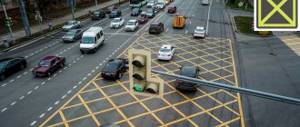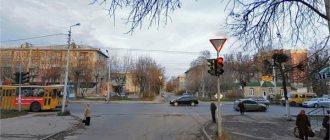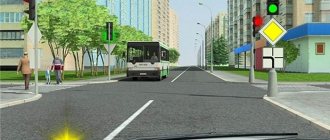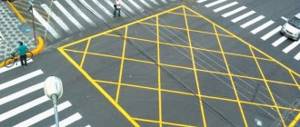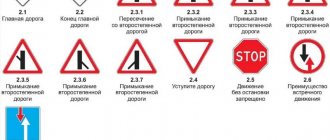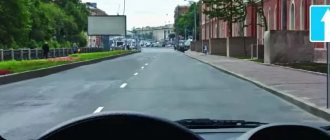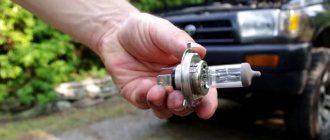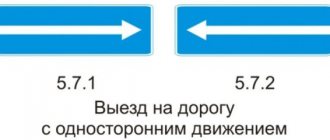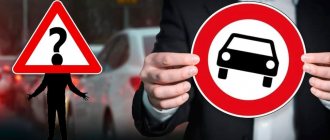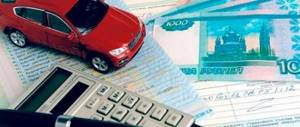We are on Twitter:
Login Registration
Automotive news
Rules for the movement of heavy trucks in the automatic weight control zone have been adopted. The Federal Tax Service has approved the application form for the death or destruction of a vehicle. In Russia, it is forbidden to disembark children without a ticket from buses. A new sign 6.22 has been introduced in the traffic rules - “photo and video recording” Testing for alcohol dependence has been postponed for another year. The Ministry of Health has updated the requirements for completing car first-aid kits, the Ministry of Transport has approved the procedure and terms for storing diagnostic maintenance cards. Obtaining permission for international transport will now be done in a new way. You can now check your MTPL policy for authenticity online. The Central Bank has set new tariffs for MTPL.
/ Legal articles on the topic of automobile law / Traffic rules and safety issues / Leaving the yard - an intersection or not?
Is leaving the yard an intersection or not?
Every day, millions of motorists from large and small cities in Russia leave their yards on the road in order to go to work or on other matters.
How many of them think about what leaving the yard is from the point of view of the Traffic Rules and who should let whom pass? As a rule, drivers ask this question only when they get into an accident and begin to find out who is right and who is wrong.
Today on “Auto Lawyer” we will discuss the topic of whether leaving the yard is an intersection or not, and will also touch on some other issues.
How to determine?
According to the rules, leaving the adjacent territory is not an intersection, but it is not always easy to distinguish them.
Signs of the surrounding area are as follows:
- Lack of road signs typical for intersections.
- The surrounding area is always a secondary road.
- There will be no traffic lights when leaving such an area.
How to travel safely
In order not to provoke an accident when entering the main road, you need to make sure that there are no obstacles and realistically assess the capabilities of your car. According to general traffic rules, the driver must leave the road intersection immediately after exiting.
The car enthusiast must understand how much time he will spend to complete his maneuver. When driving onto the main road, you need to take into account a number of external factors:
- weather;
- quality of the road surface (crushed stone, sand, clay, etc.);
- extreme visibility;
- the presence of snow, ice or puddles on the road surface.
After entering the intersection, the driver must speed up his car so that other participants cannot catch up with him. You need to be extremely careful and not allow the vehicle to stop, since other motorists follow the rules and know about their advantage and may not slow down when approaching the intersection. As a result, there may simply not be enough time and distance for emergency braking.
Right turn
When leaving a secondary road on the main road, a motorist must follow the rules for crossing intersections, including unregulated ones. When turning right, he must take the extreme right position, make sure there are no obstacles: no one is approaching from the left and no one is making a U-turn from the oncoming lane. Only after this start moving. With such a maneuver, the car should be strictly in the rightmost lane in case of multi-lane traffic.
You need to start your maneuver only after you are sure of the intentions of other motorists.
For example, a person is moving in the right lane with the right turn signal on, having forgotten to turn it off at the previous intersection. Yes, on many cars it turns off on its own, but still. Another traffic participant intends to drive straight ahead with his turn signal on. Having started to move, leaving the additional roadway will provoke an emergency situation. In the event of an accident, it will be quite difficult to prove your case.
U-turn and left turn
When turning or making a U-turn, the driver needs to take the extreme left position closer to the center of the roadway. Next, make sure that no vehicles are approaching from either the left or the right. And only then begin to move to the dividing strip, as soon as you reach it, at this moment, and jump out to the left into your lane.
When making a turn, the driver is allowed to occupy any free lane. And then change to the required lane according to the road rules.
In the case of a U-turn, the driver must perform the same actions as when turning: drive to the median, enter the lane of passing traffic and turn back. If a motorist decides to turn around right at the edge of the roadway, he will grossly violate the road rules, as he will end up in oncoming traffic. This action is strictly prohibited, as it increases the risk of an emergency, even if no one is moving towards you.
Leaving the surrounding area
According to traffic rules, road users, when entering the main road from an adjacent one, are required to yield to others who have priority over them. This rule applies when traveling from adjacent areas: courtyards, gas stations, etc.
The rules clearly state that such areas are not intersections. However, the order and priority of travel follows the same principle: drivers on the main road have priority. Therefore, a motorist standing on an adjacent roadway is obliged to let others pass in all cases, regardless of the direction of travel.
Driving through intersections
Driving through uncontrolled intersections on a secondary road is regulated by a set of rules, clause 13.9. They determine priority for road users. Cars on the main road have priority. The remaining vehicles must wait until they complete their maneuver, and only then begin to perform theirs.
Trams have an advantage over cars and motorcycles when they are on an equivalent roadway.
Other cases
Any maneuver that involves moving from a secondary roadway to the main one must be completed as quickly as possible so as not to interfere with other cars. But before driving, the driver must make sure that his actions are safe. This applies to uncontrolled and signalized intersections. The order of crossing the latter is regulated exclusively by permissive traffic light signals. Such situations are regulated by paragraphs 13.4-13.7 of the Traffic Rules.
Departure
This area is considered a secondary road, so you need to behave accordingly. That is, when leaving it on the main section of the road, the driver is obliged to give way to all traffic participants moving along the main road. It doesn't matter if they are cars, cyclists or people, they will still have traffic priority.
When leaving, you should pay special attention to the left side of the road, because it is in this direction that the leaving car usually turns.
If you need to exit to the left, you will have to pay equal attention to both sides.
Important Features
The surrounding areas have their own special rules that must be followed.
- The permissible speed is not higher than 20 km/h.
- Pedestrians here have priority over cars; they can safely walk along the roadway if this does not interfere with cars.
- If you need to turn when leaving, you must first take a place in the lane in which direction the turn will be made.
- You cannot enter this zone for through traffic only.
Penalties for violation
In such territories, many violations can be committed, the punishment will vary depending on the offense.
- A driver driving in the opposite direction will be fined five thousand rubles , as this is equivalent to driving in the oncoming lane. In addition, he may be deprived of his license for six months.
- There are sometimes prohibition signs at the border of the road and the adjacent area . For violating them, the driver will be fined five hundred rubles.
- The most common violation in such zones is driving through courtyards, the fine for this is one and a half thousand rubles . And if we are talking about Moscow, then the fine there will be higher, about three thousand rubles.
Issues relating to motorists' rights are often more important than they appear at first glance. A driver may lose his license or suffer other severe penalties due to ignorance or misinterpretation of laws and regulations. Do not be lazy to dive deeply into the essence of the issue being studied, do not hesitate to ask advice from professionals.
Exit to the main road from a secondary road according to traffic rules is regulated by clause 13.9. According to the rules, the driver is obliged to let vehicles approaching an uncontrolled intersection along the main roadway pass. To designate such areas, signs 2.1, 2.4 and 8.13 are installed, which regulate the order of travel. In their absence, the main road is considered to be a paved road, and the secondary road is considered to be a dirt road. However, in real life everything is not so simple.
Turning and other maneuvers from adjacent areas
In some cases it is convenient to use such a zone for turning around. First you will have to assess the situation on the road, for example, if there are a lot of cars on the road, it is better to use the area on the left; in other cases, the area on the right will be more convenient for this.
You can enter the zone on the right side from the front, turn around there and then drive out the same way.
If you make a U-turn on the roadway located on the left side, then you just need to drive into it in front and drive out in reverse, turning the car in the right direction.
Concept
The territory adjacent to the highway is those areas and objects that are directly adjacent to the roadway, are part of the road infrastructure, and provide comfortable service for cars or a temporary stop.
But their use must necessarily occur in accordance with the Rules, so as not to violate the general order. Let’s say that when leaving the pedestrian path area, it is prohibited to enter the traffic lane through a turn to the left.
Long-term driving and parking are not permitted on these paths, but you can drive a short distance without people around if there is no stop sign.
Features of such areas and examples:
| Specifics | Examples |
| Isolation or merging with the road. | Any area that extends beyond the line of the roadway, but merges with roads, allowing cars to drive onto them. |
| Performing vehicle maintenance functions | Gas station, for example. |
| Ensuring the safety of passengers and pedestrians | E.g. drive-in pockets for shuttle buses |
| Creating a safe temporary stop for cars that need it. | Road markings - safety islands for emergency stops. |
| Keeping the car away from the moving stream without violating the Rules. | This could be a requirement from a police officer to move off the roadway to an area where a traffic police station is installed. |
Traffic in these (and other) types of adjacent areas is necessarily regulated by the Traffic Rules. Despite the fact that through movement cannot be carried out here, nevertheless, cars also drive along them.
This means that such elements of road infrastructure are also included in high-risk areas due to the presence of moving vehicles on them.
Landscaping may include the installation of road signs to, for example, prohibit leaving the roadway from the yard to the left, etc. Therefore, these areas are subject to traffic regulations.
Parking
Parking in the surrounding areas is permitted, but certain conditions must be observed so as not to disturb other cars and people moving through this area.
- You cannot stand with the engine running for more than five minutes.
- It is prohibited to leave trucks weighing more than 3.5 tons in yards.
- You can park your car only in specially designated areas so as not to interfere with the movement of other vehicles.
- You cannot leave your car on the lawn; the violator will have to pay a fine for this.
- If the other end of the road in the yard is less than five meters, you cannot stop on it.
DD rules for traffic in the adjacent territory
As for the movement of vehicles in the area adjacent to roads, there are a sufficient number of restrictions in force.
The following general rules will need to be observed:
| Scope of application of the standards | Rules |
| Permitted speed | No higher than 20 km/h |
| Driving skills training | Prohibited |
| Keep the car with the engine running | For more than 5 minutes. |
| Park trucks whose weight exceeds 3.5 tons. | Forbidden |
| Park the car on the grass strip. | Strictly prohibited |
| Actions regarding pedestrians | The area is primarily for pedestrians. You need to give way to people on foot. |
But in addition to the general conditions of how to move through the adjacent territory, there are also individual nuances. Thus, the road leading into the yard must be used in a certain way.
Parking and parking in areas of drive-in pockets, “islands” and other places is also carried out in the order determined in the traffic rules. Therefore, all these details should be considered separately.
Entry and exit
The rules for entering or exiting the adjacent territory directly depend on which side it is located in relation to the highway.
Both options should be considered:
| Location | |
| On right | Left |
| 1. You need to drive a little forward. 2. Then stop. 3. Let moving cars pass. 4. Reverse into the adjacent territory. 5. You can leave only after turning on the left turn signal and adequately assessing the free space between moving cars on the main road. | 1. A signal is turned on, notifying other motorists of the intention to make a turn to the adjacent zone. 2. The car should already be moving on the far left side - closer to the adjacent territory. 3. Oncoming cars should be allowed to pass. 4. The driver enters the area ahead, but it is advisable to stay on the right side. This must be done in order not to block the exit route for those cars already on the site. 5. You should drive out backwards, but only after the driver is completely sure that no one is driving on the main road. |
When it is necessary to leave the adjacent territory, then one single important rule comes into play. First, all moving cars are allowed to pass along the roadway, and then you can drive out to the right.
In this case, you should also pay attention to the movement of cyclists or pedestrians. For example, this must be done when leaving the territory of a gas station (gas station).
What a flashing green traffic light means according to traffic rules is explained in the article: traffic lights in traffic rules. Read about preferential payment of fines for traffic violations here.
Movement
It is also necessary to drive on the adjacent territory, keeping to the right. You should enter or exit from the side that is provided for these purposes - for example, when you need to enter a bus station or gas station.
When driving, it is often very difficult to immediately determine the intersection ahead, or just the adjacent area. Therefore, you should understand how they differ.
Regarding whether to allow a pedestrian to pass or not - in adjacent areas that belong to courtyards or have sidewalks, pedestrians are given priority for movement.
Some restrictions:
- It is forbidden to drive backwards;
- no need to make turns in several maneuvers;
- You should always give way to the one driving on the right.
How to distinguish an intersection from the surrounding area:
| Rule | Orientation |
| Signalized intersections are equipped with traffic lights. | As soon as the driver ahead notices the presence of a traffic light, or corresponding road signs, markings, this means there is an intersection or a turn in front of him. |
| The adjacent territory is not equipped with traffic lights or road signs. | When the motorist ahead does not see traffic lights or signs, he can already understand that this is not a turn or intersection, but an adjacent zone. |
Parking
Entering and leaving a parking space is done in the same order and using the same algorithm as in the case of a right-hand or left-hand adjacent zone.
There is no through passage here, and spaces for cars are marked out on the site with special markings.
The car should be parked strictly within the parking space, delimited by the line designated in the Rules by number 1.1.
Such areas can be located in the city, near buildings, in courtyards close to the roadway, or outside the populated area, along roads.
Parking
Parking areas where you can stop temporarily are equipped with special signs or markings. The same applies to signs that prohibit parking.
For example, yellow markings in a zigzag, drawn closer to the side of the road, or with an entry pocket, allow only passenger vehicles (including taxis) to stop there.
If you leave a parking lot in the opposite direction, then this can be regarded as driving in the oncoming lane. In a parking lot, if you intend to leave, you should first give way to a car moving between the rows.
U-turn
The problem with U-turns made on the roadway often arises because it is simply narrow. In such situations, you can use a section of adjacent territory in order to make a safe turn. Of course, this is done if road signs and rules allow the maneuver.
The most important thing is not to create any interference for other road users. Whether it is a parking lot or a gas station site, when the driver needs to turn around to enter the territory, he should first make sure that there are no obstacles to progress.
Case studies
To better understand how this rule works, it is better to consider specific examples; they will help you understand how to behave in controversial situations.
- A simple example : a car leaves the arch of a residential building, how do you know if this is considered an adjacent area? It’s quite easy to understand here, since the rules clearly state that the courtyard of a residential building belongs to the category of adjacent territories.
- Another common situation is that two cars want to enter the yard at the same time, one has already begun the maneuver and entered the yard area. And then another car comes out of it, trying to get out - what to do in such a situation, who should yield to whom? This is an “oncoming traffic” situation, and the rules do not contain specific information about this; drivers will have to figure it out on their own. Therefore, it is very important to let all cars out of the yard before entering and only then drive in yourself, so as not to find yourself in such an unpleasant situation. But if this does happen, the driver who has more room to maneuver and who will not be interfered with by other cars must yield.
Fines
It is much easier to violate traffic rules in the adjacent territory - and practice confirms this. At the same time, drivers often do not even have malicious intent.
But the inspector is unlikely to heed your pleas that you allegedly did not understand what the sign refers to, so he will calmly issue a fine, using your mistake against you.
- If, when maneuvering from the adjacent territory, you find yourself in oncoming traffic, you will pay 5 thousand rubles or lose your license for 6 months.
- If you pass a prohibitory sign, prepare 500 rubles.
- If you decide to take a shortcut and try to drive through the adjacent territory, expect a fine of 1.5 thousand rubles.
Violation of other rules - driving while drunk, failing to give way, exceeding the recommended speed, etc. - are also punished with rubles on a general basis.
Well, now you know how to use adjacent sections of the road to make a U-turn, and you have more signs to identify the adjacent section.
Finally, one more piece of advice: if you are unsure, don’t take risks! Or maybe you have your own secrets for recognizing the surrounding area? Share in the comments.
If you liked the article, repost it to your friends on social networks. And I, Evgeny Borisov, say goodbye! Bye bye!
Traffic rules are not always easy to understand; car owners often have many questions. One of the difficult topics is leaving the adjacent territory; every driver can make mistakes when performing this maneuver - both a novice and an experienced one.
At first glance, it may seem that this topic is quite controversial and that is why car owners have so many questions. But once you delve deeper into the study of this topic, much becomes clearer.
